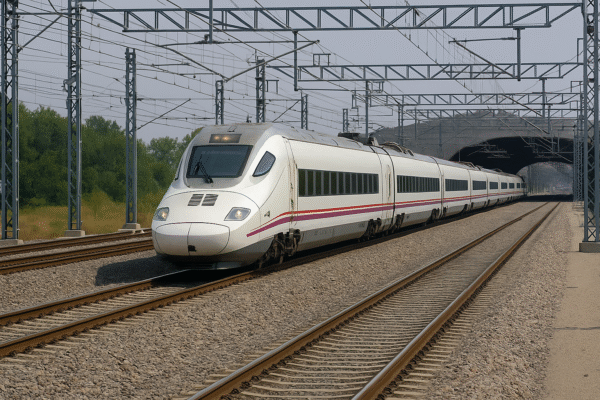Spain’s Vision for Faster, Greener, and More Connected Travel
Spain is taking a bold step to transform its transportation landscape with a high-speed rail bypass linking the Madrid–Barcelona and Madrid–Levante corridors. This strategic project, spearheaded by Adif Alta Velocidad, is halfway complete and represents a key investment in the nation’s mobility future. The goal is simple yet ambitious: to make travel faster, more convenient, and more sustainable for millions of passengers every year.
The Heart of the Project: Seamless Rail Integration
The project’s defining feature is a direct rail link that allows trains to bypass intermediate stops when traveling between northern, eastern, and southern Spain. A new standard-gauge tunnel will connect Chamartín station in northern Madrid with Puerta de Atocha in the south, enabling uninterrupted travel between the country’s major high-speed lines. This eliminates the need for passengers to change trains, streamlining the journey and enhancing comfort.
Another major advantage is the integration of Adolfo Suárez Madrid–Barajas Airport into the high-speed network. This will allow passengers to travel directly between the airport and cities such as Barcelona, Valencia, and Alicante, making Spain a more attractive transit hub for international travelers.
Boosting Tourism and Economic Growth
The bypass is expected to deliver a strong boost to tourism, especially in regions like Aragon, Catalonia, Valencia, Alicante, and Murcia. Easier and faster connections will encourage travelers to explore more destinations, while businesses will benefit from improved access to new markets. The resulting increase in tourism revenue, hotel stays, and cultural visits is projected to support thousands of jobs and strengthen regional economies.
For domestic travelers, the improved network will make weekend trips, conferences, and business meetings between cities more viable, further integrating Spain’s economy and cultural exchange.
Infrastructure Upgrades and National Rail Strategy
The bypass is part of a broader modernization plan that includes major upgrades to Madrid’s rail stations. Puerta de Atocha and Chamartín are being enhanced to handle higher passenger volumes and facilitate quicker transfers. A future underground through-station at Atocha will serve as a centralized hub, allowing smoother transitions between different lines and improving the efficiency of the entire rail network.
By connecting the high-speed corridors in a single, integrated system, Spain is laying the groundwork for a more resilient, user-friendly transport network capable of meeting the needs of future generations.
Sustainability at the Core
Beyond speed and convenience, the project plays a vital role in Spain’s sustainability goals. High-speed rail is one of the most energy-efficient modes of long-distance transport, producing significantly fewer carbon emissions than air or road travel. By making rail more accessible and competitive, the bypass encourages more travelers to choose the train over less sustainable options, contributing to the reduction of greenhouse gases.
The use of advanced construction techniques and materials is also designed to minimize environmental impact during the build phase. Once complete, the new infrastructure will support a shift toward greener mobility across the country.
Progress and Timeline
Construction began several years ago and has reached the halfway mark by mid-2025. The investment exceeds €110 million, with the aim of completing the project within the next two to three years. Once operational, the bypass will redefine high-speed travel in Spain, reducing congestion at central stations and shortening journey times across multiple routes.
Passengers traveling between Barcelona and Valencia, or between Alicante and northern Spain, will no longer need to pass through time-consuming transfer points. Instead, the direct connection will offer a smooth and efficient experience.
Spain’s Rail Legacy and Global Standing
Spain already boasts one of the most extensive high-speed rail networks in the world, ranking first in Europe and second globally. Since the launch of its first high-speed line in 1992, the network has expanded to nearly 4,000 kilometers, serving millions of passengers annually. This bypass builds on that legacy, reinforcing Spain’s position as a leader in efficient, safe, and sustainable transportation.
Summary Table
| Feature | Details |
|---|---|
| Purpose | Link Madrid–Barcelona & Madrid–Levante high-speed corridors |
| Investment | Over €110 million |
| Construction Status | 50% complete as of mid-2025 |
| Key Infrastructure | Standard-gauge tunnel; direct airport access |
| Regional Benefits | Boosts tourism and business in Aragon, Catalonia, Valencia, Alicante, Murcia |
| Station Upgrades | Atocha through-station; Chamartín improvements |
| Environmental Benefits | Lower carbon emissions; promotes sustainable travel |
| Network Impact | Enhances Europe’s largest high-speed rail system |
Conclusion
Spain’s high-speed rail bypass between Madrid, Barcelona, and the Levante region is more than an infrastructure project — it’s a transformative shift in how people and goods move across the country. By cutting travel times, expanding tourism opportunities, and aligning with sustainability targets, the project strengthens Spain’s economic resilience and global reputation. Once complete, it will stand as a benchmark for integrated, eco-friendly transportation, benefiting residents, businesses, and visitors for decades to come.
For more travel news like this, keep reading Global Travel Wire
















